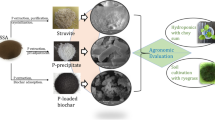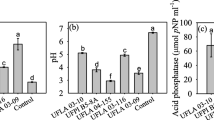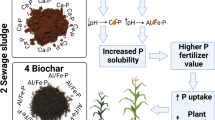Abstract
Sewage sludge ashes provide interesting possibilities to recycle phosphorus (P) to soil, although the immediate plant availability is often low. The objective of this work was to increase the P-fertilising effect of sewage sludge ash through inoculation with the phosphate-solubilising fungus Penicillium bilaiae. In a soil incubation study, ash amendment enhanced the content of water-extractable P, but in contrast to previous in vitro experiments, inoculation with P. bilaiae did not further increase P availability, probably due to limited competitiveness of the fungus in soil. In a micro-plot field trial, a moderate P fertiliser effect of the ash was found without any additional effect of P. bilaiae ash inoculation on plant biomass and P-uptake. However, soil microbial functions determined by the MicroResp™ method were not negatively affected by the ash amendment. In conclusion, inoculation with P. bilaiae did not prove to be a suitable strategy to enhance P availability from sewage sludge ash. A better insight into the fungus’ ecology and colonisation ability in soil and rhizosphere as well as into its interactions with ash P is needed to further develop such alternative P-fertilising approaches.


Similar content being viewed by others
References
Bååth E, Frostegård Å, Pennanen T, Fritze H (1995) Microbial community structure and pH response in relation to soil organic matter quality in wood-ash fertilized, clear-cut or burned coniferous forest soils. Soil Biol Biochem 27:229–240
Bérard A, Mazzia C, Sappin-Didier V, Capowiez L, Capowie Y (2014) Use of the MicroResp™ method to assess pollution-induced community tolerance in the context of metal soil contamination. Ecol Indic 40:27–33
Bierman PM, Rosen CJ (1994) Phosphate and trace metal availability from sewage-sludge incinerator ash. J Environ Qual 23:822–830
Campbell CD, Chapman SJ, Cameron CM, Davidson MS, Potts JM (2003) A rapid microtiter plate method to measure carbon dioxide evolved from carbon substrate amendments so as to determine the physiological profiles of soil microbial communities by using whole soil. J Appl Environ Microbiol 69:3593–3599
Chapman SJ, Campbell CD, Artz RRE (2007) Assessing CLPPs using MicroResp TM. A comparison with Biolog and multi-SIR. J Soils Sediments 7:406–410
Chen M, Graedel T (2016) A half-century of global phosphorus flows, stocks, production, consumption, recycling, and environmental impacts. Glob Environ Chang 36:139–152
Cieślik BM, Konieczka P (2017) A review of phosphorus recovery methods at various steps of wastewater treatment and sewage sludge management. The concept of “no solid waste generation” and analytical methods. J Clean Prod 142:1728–1740
Demeyer A, Nkana JV, Verloo M (2001) Characteristics of wood ash and influence on soil properties and nutrient uptake: an overview. Bioresour Technol 77:287–295
Frossard E, Condron LM, Oberson A, Sinaj S, Fardeau J (2000) Processes governing phosphorus availability in temperate soils. J Environ Qual 29:15–23
Gómez-Muñoz B, Pittroff SM, de Neergaard A, Jensen LS, Nicolaisen MH, Magid J (2017) Penicillium bilaii effects on maize growth and P uptake from soil and localized sewage sludge in a rhizobox experiment. Biol Fertil Soils 53:23–35
Herrmann L, Lesueur D (2013) Challenges of formulation and quality of biofertilizers for successful inoculation. Appl Microbiol Biotechnol 97:8859–8873
Herzel H, Krüger O, Hermann L, Adam C (2016) Sewage sludge ash—a promising secondary phosphorus source for fertilizer production. Sci Total Environ 542:1136–1143
Imparato V, Hansen V, Santos SS, Nielsen TK, Giagnoni L, Hauggaard-Nielsen H, Johansen A, Renella G, Winding A (2016) Gasification biochar has limited effects on functional and structural diversity of soil microbial communities in a temperate agroecosystem. Soil Biol Biochem 99:128–136
Jeffery S, Verheijen FG, van der Velde M, Bastos AC (2011) A quantitative review of the effects of biochar application to soils on crop productivity using meta-analysis. Agric Ecosyst Environ 144:175–187
Karamanos R, Flore N, Harapiak J (2010) Re-visiting use of Penicillium bilaii with phosphorus fertilization of hard red spring wheat. Can J Plant Sci 90:265–277
Kirchmann H, Börjesson G, Kätterer T, Cohen Y (2017) From agricultural use of sewage sludge to nutrient extraction: a soil science outlook. Ambio 46:143–154
Koppelaar R, Weikard H (2013) Assessing phosphate rock depletion and phosphorus recycling options. Glob Environ Chang 23:1454–1466
Kouno K, Tuchiya Y, Ando T (1995) Measurement of soil microbial biomass phosphorus by an anion exchange membrane method. Soil Biol Biochem 27:1353–1357
Kuligowski K, Poulsen TG, Rubæk GH, Sørensen P (2010) Plant-availability to barley of phosphorus in ash from thermally treated animal manure in comparison to other manure based materials and commercial fertilizer. Eur J Agron 33:293–303
Kumar U, Shahid M, Tripathi R, Mohanty S, Kumar A, Bhattacharyya P, Lal B, Gautam P, Raja R, Panda BB (2017) Variation of functional diversity of soil microbial community in sub-humid tropical rice-rice cropping system under long-term organic and inorganic fertilization. Ecol Indic 73:536–543
Leggett M, Newlands N, Greenshields D, West L, Inman S, Koivunen M (2015) Maize yield response to a phosphorus-solubilizing microbial inoculant in field trials. J Agric Sci 153:1464–1478
Lemming C, Oberson A, Hund A, Jensen LS, Magid J (2016) Opportunity costs for maize associated with localised application of sewage sludge derived fertilisers, as indicated by early root and phosphorus uptake responses. Plant Soil 406:201–217
Lopez-Rayo S, Laursen KH, Lekfeldt JD, Delle Grazie F, Magid J (2016) Long-term amendment of urban and animal wastes equivalent to more than 100 years of application had minimal effect on plant uptake of potentially toxic elements. Agric Ecosyst Environ 231:44–53
Mackay JE, Cavagnaro TR, Jakobsen I, Macdonald LM, Grønlund M, Thomsen TP, Müller-Stöver DS (2017) Evaluation of phosphorus in thermally converted sewage sludge: P pools and availability to wheat. Plant Soil 418:307–317
Magid J, Luxhøi J, Jensen LS, Møller J, Bruun S (2006) Establishment of a long-term field trial with urban fertilizers-is recycling of nutrients from urban areas to peri-urban organic farms feasible. In: Raupp J, Pekrun C, Oltmanns M, Köpke U (eds) Long-tern field experiments in organic farming, International Society of Organic Agriculture Research (ISOFAR), Scientific Series. Verlag Dr. Köster, Berlin, pp 59–78
McLaughlin MJ, Alston A, Martin J (1986) Measurement of phosphorus in the soil microbial biomass: a modified procedure for field soils. Soil Biol Biochem 18:437–443
Molina L, Ramos C, Duque E, Ronchel MC, Garcı́a JM, Wyke L, Ramos JL (2000) Survival of Pseudomonas putida KT2440 in soil and in the rhizosphere of plants under greenhouse and environmental conditions. Soil Biol Biochem 32:315–321
Möller K, Oberson A, Bünemann EK, CooperJ FJK, Glæsner N, Hörtenhuber S, Løes AK, Mäder P, Meyer G, Müller T, Symanczik S, Weissengruber L, Wollmann I, Magid J (2018) Improved phosphorus recycling in organic farming: navigating between constraints. Adv Agron 147:159–237
Müller-Stöver D, Ahrenfeldt J, Holm JK, Shalatet SGS, Henriksen U, Hauggaard-Nielsen H (2012) Soil application of ash produced by low-temperature fluidized bed gasification: effects on soil nutrient dynamics and crop response. Nutr Cycl Agroecosyst 94:193–207
Murphy DV, Stockdale EA, Brookes PC, Goulding KW (2007) Impact of microorganisms on chemical transformations in soil. In: Abbott LK, Murphy DV (eds) Soil biological fertility. Springer, Dordrecht, pp 37–59
Nannipieri P, Ascher J, Ceccherini M, Landi L, Pietramellara G, Renella G (2003) Microbial diversity and soil functions. Eur J Soil Sci 54:655–670
Nanzer S, Oberson A, Berger L, Berset E, Hermann L, Frossard E (2014) The plant availability of phosphorus from thermo-chemically treated sewage sludge ashes as studied by 33 P labeling techniques. Plant Soil 377:439–456
Nicolaisen MH, Bælum J, Jacobsen CS, Sørensen J (2008) Transcription dynamics of the functional tfdA gene during MCPA herbicide degradation by Cupriavidus necator AEO106 (pRO101) in agricultural soil. Environ Microbiol 10:571–579
Ohno T, Zibilske LM (1991) Determination of low concentrations of phosphorus in soil extracts using malachite green. Soil Sci Soc Am J 55:892–895
Oksanen J, Blanchet F G, Kindt R, Legendre P, Minchin P R, O’hara R, Simpson G L, Solymos P, Stevens M H H, Wagner H (2013) Package ‘vegan’. Community Ecology Package, version, 2(9)
Poulsen PH, Al-Soud WA, Bergmark L, Magid J, Hansen LH, Sørensen SJ (2013a) Effects of fertilization with urban and agricultural organic wastes in a field trial–prokaryotic diversity investigated by pyrosequencing. Soil Biol Biochem 57:784–793
Poulsen PHB, Magid J, Luxhøi J, de Neergaard A (2013b) Effects of fertilization with urban and agricultural organic wastes in a field trial–waste imprint on soil microbial activity. Soil Biol Biochem 57:794–802
Raymond NS, Jensen LS, Müller-Stöver D (2018a) Enhancing the phosphorus bioavailability of thermally converted sewage sludge by phosphate-solubilising fungi. Ecol Eng 120:11–53
Raymond NS, Stöver DM, Peltre C, Nielsen HH, Jensen LS (2018b) Use of Penicillium bilaiae to improve P-bioavailability of thermally treated sewage sludge − a potential novel biofertiliser. Process Biochem 69:169–177
Richardson AE, Simpson RJ (2011) Soil microorganisms mediating phosphorus availability update on microbial phosphorus. Plant Physiol 156:989–996
Ritz K, Black HI, Campbell CD, Harris JA, Wood C (2009) Selecting biological indicators for monitoring soils: a framework for balancing scientific and technical opinion to assist policy development. Ecol Indic 9:1212–1221
Sánchez-Esteva S, Gómez-Muñoz B, Jensen LS, de Neergaard A, Magid J (2016) The effect of Penicillium bilaii on wheat growth and phosphorus uptake as affected by soil pH, soil P and application of sewage sludge. Chem Biol Technol Agric 3:21
Schoumans OF, Bouraoui F, Kabbe C, Oenema O, van Dijk KC (2015) Phosphorus management in Europe in a changing world. Ambio 44:180–192
Singh RP, Agrawal M (2008) Potential benefits and risks of land application of sewage sludge. Waste Manag 28:347–358
Six J, Frey S, Thiet R, Batten K (2006) Bacterial and fungal contributions to carbon sequestration in agroecosystems. Soil Sci Soc Am J 70:555–569
Sradnick A, Murugan R, Oltmanns M, Raupp J, Joergensen RG (2013) Changes in functional diversity of the soil microbial community in a heterogeneous sandy soil after long-term fertilization with cattle manure and mineral fertilizer. Appl Soil Ecol 63:23–28
Steinbeiss S, Gleixner G, Antonietti M (2009) Effect of biochar amendment on soil carbon balance and soil microbial activity. Soil Biol Biochem 41:1301–1310
Sun D, Hale L, Crowley D (2016) Nutrient supplementation of pinewood biochar for use as a bacterial inoculum carrier. Biol Fertil Soils 52:515–522
Thomsen TP, Sárossy Z, Ahrenfeldt J, Henriksen UB, Frandsen FJ, Müller-Stöver DS (2017) Changes imposed by pyrolysis, thermal gasification and incineration on composition and phosphorus fertilizer quality of municipal sewage sludge. J Environ Manag 198:308–318
van der Bom F, Nunes I, Raymond NS, Hansen V, Bonnichsen L, Magid J, Nybroe O, Jensen LS (2018) Long-term fertilisation form, level and duration affect the diversity, structure and functioning of soil microbial communities in the field. Soil Biol Biochem 122:91–103
Vessey JK, Heisinger KG (2001) Effect of Penicillium bilaii inoculation and phosphorus fertilisation on root and shoot parameters of field-grown pea. Can J Plant Sci 81:361–366
Vogel T, Nelles M, Eichler-Löbermann B (2015) Phosphorus application with recycled products from municipal waste water to different crop species. Ecol Eng 83:466–475
Wakelin SA, Condron LM, Gerard E, Dignam BEA, Black A, O’Callaghan M (2017) Long-term P fertilisation of pasture soil did not increase soil organic matter stocks but increased microbial biomass and activity. Biol Fertil Soils 53:511–521
Wilfert P, Kumar PS, Korving L, Witkamp G-J, van Loosdrecht MC (2015) The relevance of phosphorus and iron chemistry to the recovery of phosphorus from wastewater: a review. Environ Sci Technol 49:9400–9414
Yan F, Schubert S, Mengel K (1996) Soil pH increase due to biological decarboxylation of organic anions. Soil Biol Biochem 28:617–624
Zicker T, Kavka M, Eichler-Löbermann B (2018) Soil test phosphorus as affected by phosphorus budgets in two long-term field experiments in Germany. Field Crop Res 218:158–170
Zuloagaa O, Navarroa P, Bizkarguenagaa E, Iparraguirrea A, Vallejoa A, Olivaresa M, Prietoabc A (2012) Overview of extraction, clean-up and detection techniques for the determination of organic pollutants in sewage sludge: a review. Anal Chim Acta 736:7–29
Acknowledgments
The authors would like to thank Lena Byrgesen, Thomas Hansen, Lene Vigh, Klara Gunnarsen, Jingna Liu, Daniel Ortiz Gonzalo, Enno Sonntag and Jannie Jessen for their support with the sample analysis and setting up the field trial, Jakob Magid for providing access to the field trial location and Tobias Thomsen for providing the ashes and biochars. This study was supported by Innovation Foundation Denmark (grant number 1308-00016B to the project Microbial biofertilisers for enhanced crop availability of phosphorus pools in soil and waste, MiCroP).
Author information
Authors and Affiliations
Corresponding author
Ethics declarations
Conflict of interest
The authors declare that they have no conflict of interest.
Electronic supplementary material
ESM 1
(PDF 569 kb)
Rights and permissions
About this article
Cite this article
Raymond, N.S., Jensen, L.S., van der Bom, F. et al. Fertilising effect of sewage sludge ash inoculated with the phosphate-solubilising fungus Penicillium bilaiae under semi-field conditions. Biol Fertil Soils 55, 43–51 (2019). https://doi.org/10.1007/s00374-018-1326-1
Received:
Revised:
Accepted:
Published:
Issue Date:
DOI: https://doi.org/10.1007/s00374-018-1326-1




